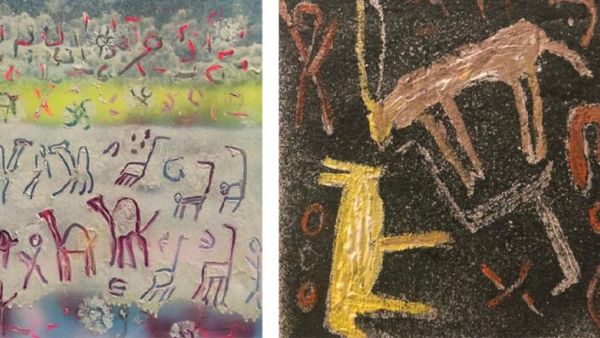Jordanian artist Rawan Adwan is known for her formative artwork inspired by Safaitic inscriptions on volcanic stones, which portray life in Jordan’s north-eastern desert from over 3,000 years ago.
She began her creative journey with these ancient inscriptions in 2003 while she was working at the Jordan Archaeological Museum. Inspired by a book on Safaitic inscriptions, she dedicated her art to “bringing them to life” through her paintings.
"A Legacy of Harmony, 2016" by Rawan Al Adwan. "My artistic objective is to breathe life into forgotten ancient societies and their values, through redrawing and adding vibrant colors to them..." #womansart pic.twitter.com/Gdcgg5hHjx
— Cynthia Cyrus (@scholar_farmer) January 25, 2022
During a seminar titled “A Passionate Overview of Safaitic Carvings” organised by the Jordanian Artists Association (JAA) on Tuesday, Adwan discussed the history, styles, and recorded sites of the rock art.
She said that these inscriptions are one of the oldest visual records of the life of ancient humans portrayed through symbols that have been painted or engraved onto rocks and the walls of caves.
Did some cool AI art renderings of #Safaitic inscriptions I found in eastern Jordan! Super unique photo progression - pic.twitter.com/FYyN7d9xKQ
— Jesse Marks جيسي ماركس 马辙新 (@JesCMarks) July 6, 2022
Some of the inscriptions can be dated back to over 40,000 years BC, according to Adwan.
Apart from Jordan, rock art can be found in almost every continent in the world. Common features of rock art include illustrations of people and animals, as well as scenes of daily life, rituals, and dances, according to Adwan.
Safaitic inscriptions portray the history and lifestyle of the Arabs in ancient times, and reflect their interest in literacy, philosophy and astronomy. “They are also evidence of how the ancient Arabs lived in peace and harmony with the surrounding environment,” she said during the seminar.
In the younger Safaitic rock art from #Jordan, there are depictions of the Syrian wild ass, donkeys, horses, and possibly hybrids. The wild ass is depicted as being hunted and referred to in the inscriptions as 'ass'. 3/ pic.twitter.com/J46KiXVCvj
— Nathalie Brusgaard (@natbrusgaard) January 20, 2022
“Some inscriptions also indicate environmental changes in the region, portraying trees and animals that no longer exist in the Jordanian desert,” Adwan added, noting that Safaitic rock art can also be found in parts of Saudi Arabia, Syria, Lebanon and Iraq.
She also pointed out the importance of implementing a plan to preserve rock art in Jordan, as it “carries great significance as part of Jordan’s historical heritage” and can reveal a lot about the life and beliefs of people who lived in this area thousands of years ago.
April News @NahlaInk: Interviewing British-Syrian poet @darwish_amir, author of 'Dear Refugee' book, and featuring British-Jordanian artist Rawan Adwan, whose work is inspired by the Safaitic inscriptions and rock art to be found in Harrah desert #Jordan: https://t.co/13Dmfmln5D pic.twitter.com/iIKlTJzJK5
— Nahla Al-Ageli (@NahlaInk) April 4, 2019
“My goal is to shed light on the importance and beauty of Safaitic rock art and to introduce it to the world through modern artwork because it’s a national treasure that I take pride in,” Adwan continued, noting that she has so far completed over 70 pieces inspired by these ancient inscriptions.
She added that art is the best and easiest tool you can use to deliver a message because it has such a pleasant and moving effect on people.








